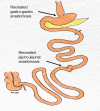Reversal of Roux-en-Y Gastric Bypass to Normal Anatomy in a Severely Malnourished Patient After Metabolic Bariatric Surgery
- PMID: 39525114
- PMCID: PMC11550883
- DOI: 10.7759/cureus.71240
Reversal of Roux-en-Y Gastric Bypass to Normal Anatomy in a Severely Malnourished Patient After Metabolic Bariatric Surgery
Abstract
Obesity stands as a prominent health challenge in our society, with metabolic bariatric surgery (MBS) emerging as a solution due to its efficacy in addressing obesity-related type 2 diabetes mellitus (T2DM). Roux-en-Y gastric bypass (RYGB) and one-anastomosis gastric bypass (OAGB) remain the most common MBS after sleeve gastrectomy. Complications from RYGB are uncommon but include anastomotic stricture, marginal ulcers, small bowel obstruction, and nutritional complications. We present a 52-year-old lady with an initial body mass index (BMI) of 27.6 kg/m2 and poorly controlled T2DM who presented with generalized body weakness and uncontrolled weight loss after an RYGB performed four months earlier. She was cachexic with a BMI of 17 kg/m2,with generalized anasarca with a multitude of electrolyte disturbances. After nutritional optimization, she underwent a reversal surgery back to normal anatomy. Reversal of RYGB to normal anatomy is a complex surgical procedure and is often the last resort undertaken in patients experiencing severe complications from the initial surgery. Indications include malnutrition, severe dumping syndrome, excessive weight loss, and recalcitrant marginal ulcers. Our case outlines the importance of proper patient selection for MBS and highlights the preoperative management of RYGB reversal to normal anatomy. We also describe the surgical procedure using a stepwise approach. In conclusion, the reversal of RYGB to normal anatomy should only be undertaken after a careful period of prehabilitation to reduce perioperative complications. The inclusion of dietitians, endocrinologists, and physiotherapists is crucial to ensure the best possible outcome.
Keywords: diabesity; metabolic syndrome; refeeding syndrome; rygb complications; rygb surgery.
Copyright © 2024, Sadu Singh et al.
Conflict of interest statement
Human subjects: Consent was obtained or waived by all participants in this study. Conflicts of interest: In compliance with the ICMJE uniform disclosure form, all authors declare the following: Payment/services info: All authors have declared that no financial support was received from any organization for the submitted work. Financial relationships: All authors have declared that they have no financial relationships at present or within the previous three years with any organizations that might have an interest in the submitted work. Other relationships: All authors have declared that there are no other relationships or activities that could appear to have influenced the submitted work.
Figures
References
-
- IDF Diabetes Atlas: global estimates for the prevalence of diabetes for 2015 and 2040. Ogurtsova K, da Rocha Fernandes JD, Huang Y, et al. Diabetes Res Clin Pract. 2017;128:40–50. - PubMed
-
- Effect of Roux-en-Y gastric bypass for patients with type 2 diabetes mellitus and a BMI . Ji G, Li W, Li P, et al. Obes Surg. 2020;30:2631–2636. - PubMed
-
- 2022 American Society for Metabolic and Bariatric Surgery (ASMBS) and International Federation for the Surgery of Obesity and Metabolic Disorders (IFSO): indications for metabolic and bariatric surgery. [ Dec; 2024 ];Eisenberg D, Shikora SA, Aarts E, et al. Surg Obes Relat Dis. 2022 18:1345–1356. - PubMed
-
- Institute for Public Health. National Health and Morbidity Survey (NHMS) 2023: non-communicable diseases and healthcare demand - key findings. Shah Alam, Selangor: Institute for Public Health, National Institutes of Health (NIH), Ministry of Health Malaysia; 2024.
Publication types
LinkOut - more resources
Full Text Sources
Research Materials

